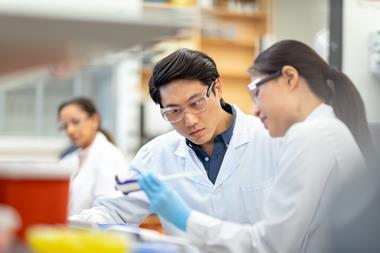Andy Extance logs on to learn how massive open online courses could attract new students, improve education and help fill the global education gap
Jonathan Agger’s first reaction to massive open online courses (Moocs) providing education over the internet was fairly typical among academics. ‘Why would universities shoot themselves in the foot by putting their information on the web for free?’ he asks.

Yet the University of Manchester lecturer is now one of three instructors on a physical chemistry Mooc, after the university signed a deal to produce courses for US Mooc provider Coursera. ‘There weren’t many chemistry [Moocs], certainly not physical chemistry, available,’ Agger explains, ‘and that was good motivation.’
Moocs have grown rapidly. Just four years after Canada’s University of Manitoba ran ‘Connectivism and connective knowledge’ (usually considered to be the first ever Mooc) the New York Times declared 2012 ‘the year of the Mooc’. In 2013, the Wall Street Journal estimated that Coursera had attracted 5 million students, and non-profit provider edX, backed by Harvard University and the Massachusetts Institute of Technology in the US, over 1.3 million.
Chemistry Moocs have a small slice of the action – less than 3% of the approximately 450 courses offered through the various platforms as of June 2013.1 Yet these few courses, and Moocs in general, have already taught educators lessons, and are posing questions about the future of chemistry instruction.
Manchester’s Moocs are intended to raise the university’s profile, so Agger’s team sought a unique selling point. They found it in perhaps the biggest problem chemistry Moocs face – practical instruction. ‘We came up with the idea of virtual labs, which were developed in conjunction with our e-learning team,’ Agger says. Together, they undertook a major effort to film experiments and code them into interactive software simulations. ‘The virtual labs went down an absolute storm,’ Agger beams. ‘The feedback has effectively been universally positive.’
The Manchester chemists also pitched the course at first year undergraduate level, and offered a high level of interaction. ‘We made an effort to answer everything,’ Agger says. As well as three lecturers and two e-learning staff, this also required input from seven PhD students. The Mooc’s students generally appreciated the level of support, although over the six week course some still got lost. ‘We had students struggling with the maths,’ Agger reveals. ‘The only answer we could give was: “We can’t really teach the subject without a certain amount of maths”.’ But at the same time, the lecturers received ‘an awful lot of feedback saying the course could have been more complicated’.
When the University of East Anglia (UEA) wanted a chemistry Mooc for its own profile-raising partnership with UK-based provider FutureLearn, it approached lecturer Stephen Ashworth. For several years, Ashworth has been doing lectures he developed while working in South Africa, demonstrating chemistry with readily-available materials. For FutureLearn, Ashworth alone ran a six-week, two-hour-per-week ‘Kitchen chemistry’ course, adapting his demonstrations for people to do at home.
‘My aim was to inspire people with simple chemistry,’ Ashworth explains. ‘I was targeting a level that the public in general could engage with, but nevertheless I saw fit to try and expand their horizons. I also realised that if there was too much material people would give up quickly. Their two hours should have been spent playing with experiments.’ Participants included parents and their children, teachers and ‘a couple of obvious chemists’. While Ashworth is not sure what the chemists got from it, other than some fun experiments, he says that it was clear from student comments that many were inspired.
Ashworth also kept the administration simple, predominantly using email reminders, web articles with experimental instructions, and links to more detailed explanations. At the end of each week, participants get an email listing materials to buy for the next week’s experiments. The shopping list may actually have been the biggest logistical challenge, for example when students struggled to find iodine for titrations to measure vitamin C levels in fruits.
MOO or OOC, but not Mooc?
With the Manchester and UEA Moocs each attracting over 9000 registrants (see box), both universities’ desire for attention may be satisfied. However, the number that actually complete all or most of a course is far smaller. But that’s not unique to chemistry – across the whole fledgling industry, less than 10% of registrants typically complete a Mooc.
Charles Dziuban from the University of Central Florida (UCF), a leading online instruction provider in the US, says this is simply the nature of Mooc learning. ‘How do students interact with a Mooc?’ he asks. ‘There are learners who drop in and out and those who are committed to staying in the Mooc. The Mooc presents a much broader array of possibilities for interacting with education than a typical course, and there’s nothing wrong with that.’ UCF has therefore ‘moved towards not framing the Mooc as a course’.
Dziuban admits that some institutions are seeking to deliver the highest standards of education through Moocs. Most notably, Georgia Tech runs a computer science master’s with US Mooc provider Udacity, in collaboration with the US telecoms giant AT&T. However, he notes that attaining the necessary level of rigour is especially difficult for chemistry. Courses should therefore consider whether the purpose is teaching people ‘technical, difficult things’ or ‘kindling their interest and finding talented students to come to universities and develop chemistry skills’.
By the numbers: 2014 chemistry Moocs
University of Manchester: physical chemistry
- Enrolled: 15169
- Visited the course: 10591
- Watched a lecture: 8101
- Browsed the forums: 2794
- Submitted an exercise: 1766
- Completed the course: 468
University of East Anglia: kitchen chemistry
- Enrolled: 9109
- Viewed at least one step: 4993
- Completed one step: 3989
- Completed more than one step: 2298
- Completed a majority of steps: 1211
- Commented in forums: 749
So while Moocs are forcing educational institutions to rethink how they do business, Dziuban doesn’t see them as a wholesale replacement for traditional degrees. ‘There are certainly innovations that replace, but I think there will be a convergence,’ he says. Dziuban thinks Moocs could be blended with traditional education and ‘adaptive learning’, where computers can be interactive teaching devices that respond to learners’ needs. ‘They could transcend higher education, secondary education and elementary education,’ he says. ‘It’s not totally inconceivable that a single Mooc could essentially expand into all those environments simultaneously. I don’t think we’ve really explored the possibilities.’
Getting practical

As Ashworth and Agger’s courses show, the many possibilities available can at least partially meet the critical challenge of doing practical chemistry from afar. Likewise, the 44-year experience of the Open University (OU) in Milton Keynes, the UK distance learning and research university, has shown how organisations can deliver practical skills at a high level. ‘From the outset it was recognised that practical work was an important part of studying science,’ notes the OU’s Eileen Scanlon.
In recent years this has evolved beyond the OU’s traditional model of field trips, day schools and residential schools. ‘As technology has developed, we have used more virtual experiences such as simulations,’ Scanlon explains. Her research contributes to the Open Science Laboratory, which the OU runs in collaboration with the Wolfson Foundation. ‘It includes remote access to laboratories and observatories, virtual laboratories and instruments,’ Scanlon continues. Current projects include a virtual flame test, and a virtual field trip that tests the chemical characteristics of soils.
Scanlon highlights that this resource emerges from the OU’s need to engage learners from a distance, and encourages those running Moocs to learn from that experience.2 Rather than just accepting a high drop-out rate, she advocates designing materials and support to improve retention. As well as designing materials that do much of the teaching themselves, interactions with other students and those running the course are important in keeping participants interested. As the owner of FutureLearn, the OU is well placed to put these recommendations into practice.
Kitchen experiments kept Ashworth’s students ‘in the main, not disgruntled’, he reflects self-deprecatingly. However, beyond just advertising chemistry degrees, his experience has showed him that Moocs could perhaps improve the degrees themselves. ‘I like the idea of a Mooc that can reach lots of people, but one has to have the time and energy to invest in them – you get out what you put in. People are getting involved, thinking about how best to put chemistry across, developing simulated and online experiments. That’s potentially powerful, because the easier it is to incorporate, the more likely it is higher education will involve much more blended learning, using different types of experience, rather than just trooping into a lecture theatre.’
Agger is using his course in exactly this way. ‘I plan to tell all my first year students on the thermodynamics course that this course is online and it might be an idea that they take it,’ he says. However, with around a third of his course’s students coming from emerging economies, he underlines that for them it might be a more viable alternative to higher education. With meeting global education needs in the conventional format estimated to ‘require four major campus universities … to open every week’3 Moocs can be a boon to such students. ‘They can be both an augmentation and a replacement,’ Agger stresses.












No comments yet